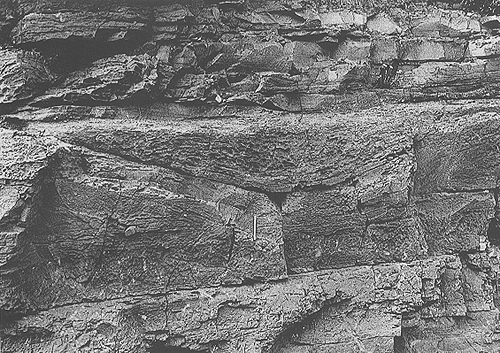
Nested scour-and-fill with pelitic plug
Plate 76

Nested scour-and-fill with pelitic plug
Plate 76
I have said before that scours are typically made by high-energy, catastrophic flows invading normally quiet environments. It is consequently common to find fossil scours on top of, or embedded by, fine-grained (pelitic) sediments, and filled by coarse materials. An opposite example is documented by plate 77. A sharply defined, troughlike surface truncates a sandstone bed and is covered by a silty pelite.
How can one explain this inversion of what is expected? There are several possible explanations: 1) the current had erosive capacity but did not transport coarse sediment because this was not available; 2) a bed load was present but bypassed this spot and was abandoned down current from it (we also say "in a more distal position"); 3) alternatively, coarse materials stopped in a more proximal position and occluded the scour. In case of occlusion, which could occur also in case 2, the water becomes still and mud can settle.
The stratigraphic unit and the depositional setting are the same as in plate 72. The sandstone bed with the scour on top can be interpreted as a crevasse deposit. If you look carefully, you can see another concave surface below the marked one, just above the pencil placed for scale. The actual base of the scour is that one. A third scour surface appears on the left: it truncates the lower one and is truncated by the upper scour. In chronological order, it is the second scour. In conclusion, there is here a stack of concave erosional surfaces. Notice that I have applied the principle of intersection, a fundamental tool for establishing temporal sequences of geological events.
Devonian Old Red Sandstone, Dunmore East, Ireland.
| Photo: G. G. Ori 1992. |